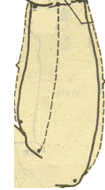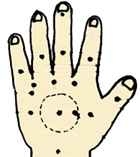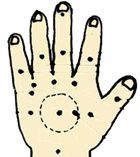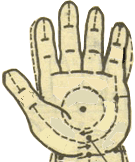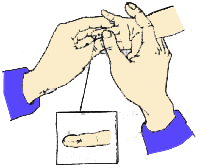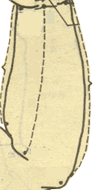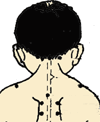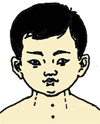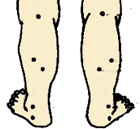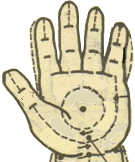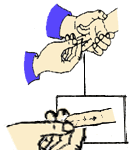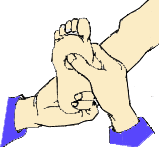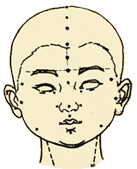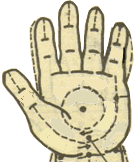Today, we have compiled a collection of commonly used pediatric tuina techniques to help manage common childhood illnesses easily. This can also be considered a nice health gift for children!Pediatric Wind-Cold Cold Massage Techniques
Wind-Cold Cold Symptoms: Symptoms include severe chills, mild fever, no sweating, headache, soreness in limbs and joints, nasal congestion, clear nasal discharge, cough with clear and thin phlegm, pale tongue, thin white coating.Common Techniques:① Press the San Guan (Three Passes) point 500 times.
② Rub the Wai Lao Gong (Outer Labor Palace) point 100 times.
Point: Wai Lao Gong (Outer Labor Palace)Location: In the center of the back of the hand opposite the Nei Lao Gong (Inner Labor Palace).Technique: Use the thumb or index finger to rub, about 50-100 times.Indications: Wind-cold cold, abdominal pain, bloating, diarrhea, intestinal rumbling, etc.③ Lift the muscle at the Jian Jing (Shoulder Well) point 5-7 times.
Point: Jian Jing (Shoulder Well)Location: At the midpoint of the line connecting the Da Zhui (Great Vertebra) and the shoulder peak, in the shoulder muscle area.Technique: Use both thumbs and index fingers to pinch the large muscle at the shoulder, about 5-10 times.Indications: Cold, convulsions, shoulder and back pain.④ Rub the Er Shan Men (Two Gates) point 50 times, applying moderate pressure and a quick speed.
Point: Er Shan Men (Two Gates)Location: In the depressions on both sides of the base of the middle finger on the back of the hand.Technique: Use both thumbs to pinch and rub, pinching 5-10 times, rubbing 100-300 times.Indications: Convulsions, fainting, body heat without sweating.
Pediatric Wind-Heat Cold Massage Techniques
Symptoms: Symptoms include high fever, slight aversion to wind or cold, sore throat, dry mouth, sweating, flushed face, nasal congestion, yellow nasal discharge, cough with yellow phlegm, red tongue edges, thin yellow coating.1. Clear the Fei Jing (Lung Meridian) 300 times, clear the Tian He Shui (Heavenly River Water) 100 times.
Point: Fei Jing (Lung Meridian)Location: On the palm side of the ring finger.Technique: ① To supplement the Fei Jing: Rotate and push on the surface of the ring finger, about 200-400 times.② To clear the Fei Jing: Push straight towards the base of the finger, about 200-400 times.Indications: Fever, cough, wheezing, chest tightness, sore throat, etc.
Point: Tian He Shui (Heavenly River Water)Location: On the inner side of the forearm, in a straight line from the wrist crease to the elbow crease.Technique: Use the index and middle fingers to push from the wrist crease towards the elbow crease, about 100-500 times.Indications: Fever, irritability, thirst, mouth sores, convulsions, and all heat syndromes.2. Press and rub the Da Zhui (Great Vertebra) point for 1-3 minutes.
Point: Da Zhui (Great Vertebra)Location: Between the 7th cervical vertebra and the 1st thoracic vertebra.Technique: Use the tip of the middle finger to press and rub, or use the thumb and index, middle, and ring fingers to apply symmetrical pressure, about 100-300 times for pressing and 10-15 times for squeezing.3. Rub the sacrococcygeal area with the palm, applying heat as needed.4. Lift the Jian Jing (Shoulder Well) point 3-5 times.
Point: Jian Jing (Shoulder Well)Location: At the midpoint of the line connecting the Da Zhui (Great Vertebra) and the shoulder peak, in the shoulder muscle area.Technique: Use both thumbs and index fingers to pinch the large muscle at the shoulder, about 5-10 times.Indications: Cold, convulsions, shoulder and back pain.5. For cough with excessive phlegm, add pressing and rubbing the Tian Tu (Heavenly Pivot) and Feng Long (Abundant Dragon) points for 1 minute each, push the Xiao Heng Wen (Small Horizontal Line) 100 times, and push the Dan Zhong (Middle of the Chest) 100 times.
Point: Tian Tu (Heavenly Pivot)Location: In the center of the suprasternal notch.Technique: Use the thumb or middle finger to press and rub, about 15-30 times.Indications: Cough, wheezing, chest tightness, nausea, vomiting, etc.
Point: Feng Long (Abundant Dragon)Location: 8 cun above the outer ankle, 1.5 cun lateral to the anterior border of the tibia, between the tibia and fibula.Technique: Use the thumb or middle finger to rub, about 1-3 minutes.Indications: Excessive phlegm, wheezing, chest tightness, etc.
Point: Xiao Heng Wen (Small Horizontal Line)Location: On the ulnar side of the little finger’s root palm line.Technique: Use the thumb or middle finger to press and rub, about 100-300 times.Indications: Bronchitis, whooping cough, pneumonia, etc.
Point: Dan Zhong (Middle of the Chest)Location: The midpoint of the line connecting the two nipples.Technique: Use the tip of the middle finger to rub, about 50-100 times; use both thumbs to push outward from the Dan Zhong point, about 50-100 times.Indications: Chest tightness, cough, vomiting, palpitations, etc.6. For high fever convulsions, add clearing the Fei Jing 300 times, clearing the Xin Jing (Heart Meridian) 300 times, pushing the Yong Quan (Gushing Spring) 200 times, and clearing the Tian He Shui 500 times.
Point: Xin Jing (Heart Meridian)Location: On the palm side of the middle finger.Technique: ① To supplement the Xin Jing: Rotate and push on the surface of the middle finger, about 100-200 times.② To clear the Xin Jing: Push straight towards the base of the finger, about 100-300 times.Indications: High fever, delirium, irritability, night crying, mouth sores, short and red urination, etc.
Point: Yong Quan (Gushing Spring)Location: At the junction of the front 1/3 and 2/3 of the sole of the foot.Technique: Use the thumb to push from the heel towards the toes, about 100-500 times. Use the tip of the thumb to press and rub, about 30-50 times.Indications: Fever, vomiting, diarrhea, five hearts heat.
Pediatric Loss of Appetite and Indigestion Massage Techniques
1. For loss of appetite, add rubbing the Ban Men (Board Gate) point 100 times, rubbing the Zhong Wan (Middle Cavity) for 3 minutes, and pressing and rubbing the Zu San Li (Leg Three Miles) point for 1 minute.
Point: Ban Men (Board Gate)Location: At the base of the thenar.Technique: Use the tip of the thumb to press and rub in the center of the thenar, about 200-400 times.Indications: Loss of appetite, fatigue, stagnation, diarrhea, abdominal bloating, etc.
Point: Zhong Wan (Middle Cavity)Location: 4 cun above the navel (the midpoint of the line connecting the lower end of the sternum to the navel).Technique: ① Rub the Zhong Wan: Use the fingertip or palm root to rub, about 2-5 minutes.②摩中脘法: Use the palm or four fingers to rub the Zhong Wan, about 5-10 minutes.Indications: Diarrhea, vomiting, abdominal pain, abdominal bloating, loss of appetite, etc.
Point: Zu San Li (Leg Three Miles)Location: 3 cun below the outer knee eye, about one finger breadth lateral to the tibia.Technique: Use the tip of the thumb to press and rub, about 1-3 minutes.Indications: Abdominal bloating, abdominal pain, loss of appetite, diarrhea, constipation, fatigue, etc.Adjust according to symptoms:If symptoms like runny nose and sore throat are severe, commonly used techniques include:① Press and rub the Feng Chi (Wind Pool) point for 1 minute.② Press and rub the Qu Chi (Pool at the Bend) and He Gu (Union Valley) points for 1 minute each.
Point: Hegu (Union Valley)Location: In the depression between the thumb and index finger, at the midpoint of the second metacarpal bone.Technique: Use the thumb to press and rub or pinch symmetrically with the thumb and index finger, about 3-5 times for pinching, 100-300 times for rubbing.Indications: Wind-cold cold, facial paralysis, toothache, etc.③ Rub the Tai Yang (Sun) point more.
Point: Tai Yang (Sun)Location: In the depression behind the eyebrows. The left side is called Tai Yang, and the right side is called Tai Yin.Technique: Use the tips of both thumbs or both middle fingers to rub on the left and right Tai Yang points. Rubbing forward is for supplementation, rubbing backward towards the ears is for draining. Rub 30 times.Indications: External heat, headache, dizziness.If there is a high fever, commonly used techniques include:① Clear the Tian He Shui 300 times, clear the Fei Jing 300 times.② Push the spine 5-10 times.Point: SpineLocation: In a straight line from the Da Zhui (Great Vertebra) to the tail vertebra.Technique: Use the index and middle fingers or the palm root to push straight down from top to bottom, about 100-300 times.Indications: Prolapse of the rectum, constipation, diarrhea, etc.③ Rub the Yong Quan (Gushing Spring) point 300 times.For children with spleen and stomach deficiency and loss of appetite, commonly used techniques include:Supplement the Spleen Meridian 100 times, push the San Guan (Three Passes) 100 times.
Point: Spleen Meridian (Spleen Earth)Location: On the radial side of the thumb.Technique: ① To supplement the Spleen Meridian: Slightly flex the child’s thumb, and the practitioner pushes along the radial edge of the child’s thumb towards the palm root, about 100-300 times.② To clear the Spleen Meridian: Push straight on the surface of the child’s thumb, about 100-300 times.Indications: Indigestion, diarrhea, vomiting, malnutrition, fatigue, etc.
Point: San Guan (Three Passes)Location: On the radial side of the forearm, in a straight line from the wrist crease to the elbow crease.Technique: Use the thumb or index and middle fingers to push from the wrist crease towards the elbow crease, about 100-300 times.
Press and rub the Zhong Wan and Zu San Li points for 1 minute each.
Point: Zhong Wan (Middle Cavity)Location: 4 cun above the navel (the midpoint of the line connecting the lower end of the sternum to the navel).Technique: ① Rub the Zhong Wan: Use the fingertip or palm root to rub, about 2-5 minutes.②摩中脘法: Use the palm or four fingers to rub the Zhong Wan, about 5-10 minutes.Indications: Diarrhea, vomiting, abdominal pain, abdominal bloating, loss of appetite, etc.
Precautions for Pediatric Tuina
1. Use a massage medium during the massage. Using a medium makes the massage smoother and prevents skin abrasions on the baby. Common household items that do not cause allergies to the baby, such as baby lotion, massage oil, or baby olive oil, can be used.
2. Mothers should trim their nails to avoid scratching the baby. Warm up your hands.
3. The room temperature should be appropriate. It is best to keep the room temperature between 20 to 26 degrees Celsius to ensure the baby is comfortable and not cold.
4. The duration should not be too long. Generally, for routine health massages, 10-20 minutes is sufficient. Morning and evening sessions are more effective. When the baby is sick, adjust according to the specific situation.
5. Do not perform tuina when the baby is too full or too hungry. Avoid massage during breastfeeding and within one hour after. Morning massages are acceptable.
6. Do not massage areas with skin damage, infection, or allergies.
7. Generally, massage in a supine position first, then in a prone position.
8. The techniques should be gentle, not heavy. Pediatric tuina requires even techniques, gentle strength, and steady depth.
Due to the different constitutions of children and the complexity of their conditions, pediatric tuina must be differentiated and handled according to seasonal, climatic, and symptomatic variations.
Disclaimer: The content of this article, if it involves formulas or therapies, is for reference only. Please do not use it casually. The article and images are sourced from the internet. If there is any infringement, please contact for removal.
Share with those who care.
The more people see it, the more health there is!
Today's Recommendations


